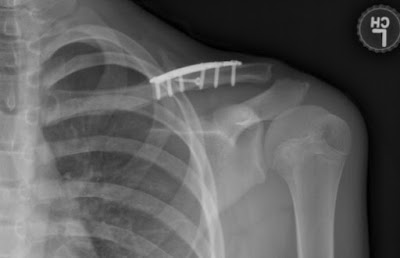By Jeffrey J. Nepple
Summer brings great opportunities for children and
adolescents to be active outdoors.
Whether it be sports camps or exploring outdoors on their bike, many
sports injuries are most common during the summer. Clavicle (also known as collarbone) fractures
are among the most common type of fractures in adolescents. Most commonly these injuries are the result
of falling directly on the shoulder (picture flying over the front of your
bike’s handlebars) or trying to catch yourself after a similar accident. Breaking your clavicle generally causes
fairly severe pain initially are often leads to a trip to an injury clinic or
emergency room that day. The clavicle is
located very close to vital structures including the lung, large blood vessels,
and important nerves. Shortness of
breath (difficulty and breathing) or numbness or weakness in your arm would be
a reason to seek immediate medical care.
The treatment of clavicle fractures is currently a very
controversial topic. Traditionally,
clavicle fractures have always been treated conservatively, or without surgery,
except for rare circumstances. Recent
studies have questioned if everyone with a clavicle fracture really does as
well as once thought. Although rare in
children and adolescents, 5-10% of displaced clavicle fractures fail to heal
(nonunion) in adults. Severe clavicle
fractures often result in significant overlap (shortening) due to the muscular
forces on the fracture fragments, and in some cases prominence on the overlying
skin. This overlap of fracture fragments
does not change during healing (termed malunion) and is generally permanent
since the clavicle (unlike many other bones) has limited remodeling potential. While many patients have no problems with
this shortening, recent studies demonstrate that when the overlap is greater
than 2 cm in adults, issues including pain and shoulder weakness are commonly
present. Surgical treatment with a plate
and screw generally restores the anatomy of the clavicle, but also has
potential rare complications. These
landmarks studies have swung the pendulum towards treating clavicle fractures
with surgery in adults.
 | |
| Top. An adolescent patient with a displaced left mid-shaft clavicle fracture. Bottom. The same patient with a surgically reduced clavicle using a plate and screws. |
However, these studies fail to inform our decisions in
children and adolescents. Are children
and adolescents just “little adults” and should be treated similarly? Should we be more or less likely to treat
them with surgery? We really don’t know
….. yet. Ongoing research may someday answer
that question. Washington University and
Young Athlete Center providers are currently recruiting 10 to 18 year old
patients with clavicle fractures to answer this question as part of a large
multicenter study. The study will track
the outcomes of patients regardless which treatment the patient, family, and
physician decide on. It will likely take
thousands of clavicle fractures to answer these questions and tell us what the
ideal treatment of clavicle fractures is in the young athlete. The good news is we are only a few years
away!


